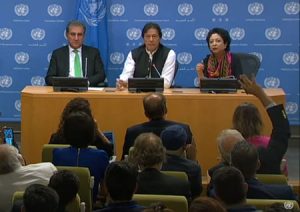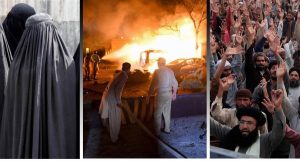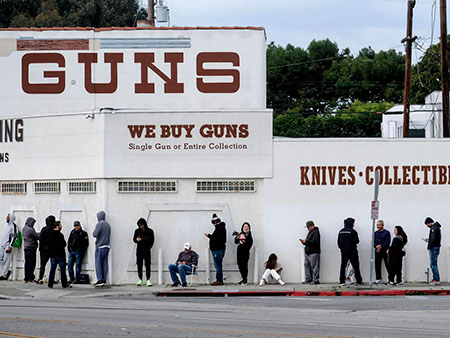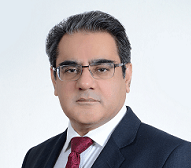For many educated Pakistanis, the Western media remains the yardstick of quality journalism. They see it as objective, impartial, fair and factual. They view even the local news and opinion as being more reliable if it is coming from the Western media.
But does this perception reflect the reality? Are Western media organisations the real paragons of unbiased and factual journalism? Is it not true that they, in general, push the agenda of their respective countries and, in particular, resort to subtle propaganda of Eurocentric views and capitalist democracy, in the garb of journalism? Doesn’t the media in the West remain aligned to the imperial designs of Western powers? Does it not act as warmonger whenever their establishments decide to invade a country, orchestrate a regime change or destroy nations to impose capitalist democracy and their so-called concept of human rights?
Iraq, Libya, Syria and Afghanistan are living-examples, in recent history, of how the West first created an enemy using the power of the media and built false pretexts and narratives to declare wars and justify invasions. The same kind of propaganda was used during the last century —beginning with the two World Wars to the Vietnam and Korean Wars.
Noam Chomsky, a renowned American activist and philosopher, in his booklet Media Control, gave an example of the “first modern government propaganda operation” in the United States under the Woodrow Wilson administration, which came to power in the middle of World War I. “The (US) population was extremely pacifistic and saw no reason to become involved in a European War. The Wilson administration was actually committed to war and had to do something about it. They established a government propaganda commission… which succeeded, within six months, in turning a pacifist population into a hysterical, war-mongering population…”
Since the days of Woodrow Wilson, the Western powers and the media have not changed tactics; in fact, they have made them even more sophisticated and lethal.
When it comes to the developing countries of Asia, Africa and South America, the Western media has been used as a tool not just to wage wars, but to build positive or negative perceptions about friendly and not-so friendly countries.
Pakistan is a glaring example of how the Western media has been resorting to subtle and not-so subtle propaganda against the state and its institutions, especially since the end of the former Soviet Union’s occupation of Afghanistan.
Now most news and opinion pieces on Pakistan are negative, one-sided and out of context. Period. If one has any doubts, check the coverage of leading Western media organisations — especially the British and the American ones. With the rise of digital media, the Western media has lowered its bar of journalism further. Now even the pretence of balance and fairness has disappeared. Whether it’s the foreign staff members of these organisations, or the locally employed journalists and freelance writers — they all sing from the same sheet. They go for the usual stereotyping of Pakistan; it is overwhelmingly described in broad strokes as a “failing state,” if not already a failed one.
The unsubstantiated allegations of state-sponsored terrorism and growing religious extremism in society top the list of coverage in which, directly or indirectly, the state institutions are held responsible. The same line of propaganda against Pakistan is followed by a small segment of our local Westernised elite, many NGOs and former leftists-turned-liberal activists of today.
They conveniently forget the West’s role in promoting militancy in many Muslim countries, including Pakistan, in the fight against the former Soviet Union. The West and its local allies also ignore the fact that Pakistan is the only country that turned the tide of terrorism on its own, paying a heavy price of sweat, tears and blood.
Another popular line of propaganda is to portray state institutions, particularly the armed forces, as the ultimate villains and show them as standing against the masses. In reality, the public at large see their armed forces as the most trust worthy institution in the country.
Similarly, the Western media glamourises and highlights the fringe centrifugal elements in Pakistan, while those mainstream forces that stand for the unity, cohesion and stability of the country are ignored and hardly given any space and voice.
Then, there is a concerted effort to play up and exaggerate the small sectarian, ethnic and provincial fissures, which may exist in any society. But for the Western media, they appear as principal contradictions and are played up as such.
Isolated incidents of individual violence against a woman, or an individual, are inaccurately reported as predominant trends. Pakistani society’s cultural and religious norms and values are reported with underlying bias and prejudice, reflecting a poor understanding of the country by design.
Interestingly, the Western media’s criteria, while reporting on Europe and North America, and even those countries falling within their imperial ambit, are different.

For example, in the case of a terrorist attack in any Western country, images and footages of violence are never shown. The names of victims are withheld until the families are informed. Even, the identity of American or European victims of terrorism — say in any Asian or African country — is never disclosed until the authorities inform the families. But no such sensitivity is shown about the local victims of terrorism, while reporting in countries like Pakistan. Yes, the Western media’s ethics and yardsticks vary from region to region, exposing its double-standards.
And this is true not just in cases of terrorism or violence. Even routine, individual crime is reported with a slant when it comes to Pakistan.
Let’s take the example of acid attacks on women. Official figures and data available with non-government organisations show that there has been more than an 80 per cent drop in the number of acid attacks in Pakistan between 2014 and 2019. Successive governments in Pakistan have managed to deal with this crime effectively — the same way they managed to rein in terrorism.
In comparison, the United Kingdom recorded one of the highest rates of acid attacks in the world. From 2014-2019, there were 1,683 acid attacks in London alone, whereas in the entire Pakistan, there were a little over 1,500 cases of acid attacks between 2007 and 2019.
While an Oscar-Award-winning documentary has been made on Pakistani victims of acid attacks, we have yet to see any such creative effort in the United Kingdom.
An interesting fact is that while acknowledging, appreciating and awarding works of Pakistan’s creative people — from filmmakers to writers and artists to journalists — only those are deemed worthy, who manage to see Pakistan through the western lens, and that too, negatively. Individuals, who echo the western line, get condescending nods of approval from the market for which their works are intended — the West. However, while telling Pakistan’s negative stories within the western framework, the local socio-economic context is ignored.
Incidentally, the headlines in the Western media portray not just Pakistani women, but Muslim women in general, as mere victims of oppression and discrimination.

But is it even fair to apply the Western yardstick to the state of Muslim women and pass such judgments? Isn’t there a difference in the core values and beliefs between the West and the Muslim World? Why is only the Western way of life considered as being politically and socially correct? A vast majority of Pakistani women are empowered and are decision-makers in their own spheres of domestic and professional lives. They command respect that emanates from our society’s core values and beliefs and many of them can rise to any level in their chosen field.

the US far eclipse those in Pakistan, contrary to media stereotyping.
The condemnable incidents of violence or discrimination against them are not a norm, but an aberration. The semi-feudal and the semi-tribal system, the backwardness and illiteracy and poor quality of education are mainly responsible for crimes against women, as is the case in many developing countries. But the Western media never raises the issue of class-conflict or socio-economic situations as they only describe such crimes in terms of a friction between modernity and Islam.
As a consequence of the exploitative capitalist system, women in the West, are also victims of harassment, sexual abuse and violence and treated and traded as commercial commodity.
Unfortunately, the western media’s reporting on women’s issues in Pakistan or other Muslim countries exposes its poor understanding of their situations and deliberate manipulation.
For example, when the Afghan Mujahideen were fighting the former Soviet Union and their allied local communists and were being supported and armed by the United States and its allies, the Western media had no problem with the bearded Afghan men, their adherence to Islam, or how they treated women, or their veils. But when the same Afghans were pitted against the West, then from Islam to the women in veils — everything became an issue.





Now with the departure of the American troops from Afghanistan, the Western media appears to be more worried about the fate of the Afghan women and children rather than that of the majority of the Afghans themselves.
While advocating women’s rights from the Western point of view, the fact that the majority of Afghan women live in a traditional tribal society and adhere to its values and customs, in line with their socio-economic circumstances, is ignored. The so-called great leap forward, which many Westerners want women to take in Afghanistan, is not possible in any predominantly tribal society. However, the Western media ignores this fact, and speaks only for a tiny Westernised local elite. And by doing this, it undermines and damages even genuine causes, which can be addressed over a period of time through mass education, development and modernisation, without falling into the trap of Westernisation.
This shows that the Western media adjusts itself in line with its state policies. When the Western establishment promotes non-state actors, they are portrayed as heroes in the media as well. And when the state interests collide with the same set of non-state actors, then everything they do or say, their customs and traditions — all are vilified.
Even in instances of hate and routine crimes, murders and mass-shootings, the Western media applies double standards in its coverage. Interestingly, the number of such crimes in the United States and the UK surpasses that of Pakistan. Yet, the heart-wrenching reporting we see on Pakistan in the Western media is seldom seen when it concerns their own countries or crime-infested cities.
There is also a deliberate attempt to stoke ethnic and sectarian tensions in Pakistan by exaggerating incidents and twisting facts. Here again, scattered acts of fringe elements or individuals are described as the norm and, overwhelmingly, the state is blamed and held responsible. The one-sided, opinionated pieces carried not just in the English language, but also in Urdu on Western media websites, attempt to fan sectarian hatred and ethnic strife by playing up and exaggerating minor or non-issues.
The latest addition to the ever-expanding propaganda hitlist of the Western media is the China-Pakistan Economic Corridor (CPEC), against the backdrop of rising tensions between China and the United States. This, again, shows that the Western media remains its master’s voice.
The almost non-existent implementation of libel and defamation laws, a weak judicial system and the absence of any monitoring framework and checks on the western media in Pakistan, let its operatives get away with the murder of facts and journalism. It is high time that the government initiates steps to monitor, regulate and develop a proper framework under which the Western media organisations are allowed to operate in Pakistan.

The writer is a senior journalist and managing editor, Narratives.



